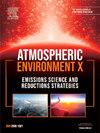Impacts of wildfire smoke aerosols on radiation, clouds, precipitation, climate, and air quality
IF 3.4
Q2 ENVIRONMENTAL SCIENCES
引用次数: 0
Abstract
Wildfires have become increasingly prevalent, impacting ecosystems, climate, and human health on a global scale. This review aims to present a comprehensive analysis of current knowledge on the environmental factors and conditions driving wildfires, the characteristics and transport of smoke emissions, along the broader impacts of wildfire smoke on the weather and climate. These impacts include changes in atmospheric radiation, cloud formation, atmospheric circulation, precipitation patterns, and air quality, as well as their effects on land cover, safety, and public health. Wildfire emissions include various pollutants such as particulate matter that alter the Earth's energy balance, reduce air quality, and impact cloud microphysics. Key interactions, such as the direct and indirect effects of smoke aerosols, affect cloud cover and lifetime, precipitation, atmospheric stability, and ultimately induce changes in weather and climate dynamics. Moreover, smoke transport extends the effects of wildfires thousands of kilometers beyond their sources, which reduces agricultural productivity, deteriorates human health, and threatens the environment. Advances in satellite retrievals and modeling techniques have improved the ability to monitor, analyze, and predict these complex interactions. Moreover, this review highlights the critical need for advancing research to more precisely quantify and project multi-scale trends in wildfire smoke and its far-reaching impact on public health, safety, infrastructure, and ecosystems. Developing more robust adaptation strategies and resilience measures is essential to effectively mitigate these complex, adverse effects on communities and the environment.
野火烟雾气溶胶对辐射、云、降水、气候和空气质量的影响
野火越来越普遍,在全球范围内影响着生态系统、气候和人类健康。本综述旨在全面分析当前关于驱动野火的环境因素和条件、烟雾排放的特征和传输以及野火烟雾对天气和气候的广泛影响的知识。这些影响包括大气辐射、云层形成、大气环流、降水模式和空气质量的变化,以及对土地覆盖、安全和公共健康的影响。野火排放物包括颗粒物等各种污染物,这些污染物会改变地球的能量平衡、降低空气质量并影响云的微物理学。关键的相互作用,如烟雾气溶胶的直接和间接影响,会影响云层覆盖和寿命、降水、大气稳定性,并最终导致天气和气候动态的变化。此外,烟雾传输将野火的影响延伸到其源头以外数千公里的地方,这降低了农业生产率,恶化了人类健康,并威胁到环境。卫星检索和建模技术的进步提高了监测、分析和预测这些复杂相互作用的能力。此外,本综述还强调了推进研究的迫切需要,以便更精确地量化和预测野火烟雾的多尺度趋势及其对公众健康、安全、基础设施和生态系统的深远影响。制定更强有力的适应战略和恢复措施对于有效减轻这些复杂的、对社区和环境的不利影响至关重要。
本文章由计算机程序翻译,如有差异,请以英文原文为准。
求助全文
约1分钟内获得全文
求助全文
来源期刊

Atmospheric Environment: X
Environmental Science-Environmental Science (all)
CiteScore
8.00
自引率
0.00%
发文量
47
审稿时长
12 weeks
 求助内容:
求助内容: 应助结果提醒方式:
应助结果提醒方式:


